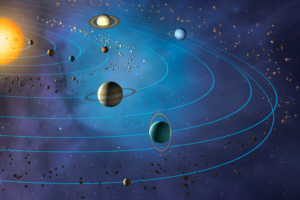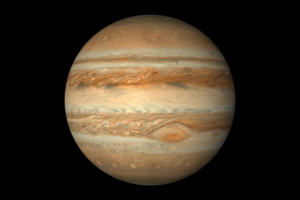10 Easiest & Brightest Deep Space Objects To See For Beginners
Disclosure: This post contains affiliate links and I may earn a small commission (at no extra cost to you) if you click through and make a purchase. Thanks in advance – I really appreciate it!
When you first purchase a telescope, your natural impulse is to aim it toward the moon and planets because they are the brightest and easiest to locate.
However, it won’t be long before most of us have the urge to look for something in the more distant deeper reaches of space.
No one will blame you if a deep space object (galaxy, star cluster, nebulae, etc.) is what you want to see with your first telescope. After all, their images that can be found in astronomy magazines and telescope packaging are quite stunning.
Unfortunately, this is how most astronomy beginners get disappointed and give up on their hobby even before they have traveled to their first stargazing location.
What To Expect When Viewing Deep Space Objects
False expectations of what can be seen through a telescope are one of the primary reasons most beginners quickly lose interest in stargazing.
We see an awesome colorful picture of a deep space object in its full glory from NASA or in an astronomy magazine/website, and we start expecting that’s what even we are going to see when we look through our beginner telescopes.
But when the time comes, we only see a white fuzzy blotch in the night sky.
This is because NASA’s cameras are quite big and expensive, and they are capable of gathering a tremendous amount of light over more time than our eyes or telescopes can.
So you must remember that the true joy for an amateur astronomer is in hunting, discovering, and finally locating a galaxy or a star cluster, especially if it’s outside the limits of your telescope.
So I highly recommend locating and observing each of the DSOs discussed in this article.
Find them and then spend some time observing them through your eyepiece. When you focus on something for longer, your brain tends to notice many more details.
To hunt for DSOs, I use smartphone apps such as Stellarium and Sky & Telescope’s Pocket Sky Atlas (available on Amazon).
How To Prepare Yourself To See DSOs
Here are a few tricks we can use to improve our viewing conditions for deep-space objects with your telescope.
Get away from the city and find a darker stargazing location.
Regardless of how large of a telescope you have, if you are observing from within a city, you will only be able to see a pale fuzzy image of even the brightest of the deep sky objects.
Even if it’s not as severe, light pollution from suburbs can still be a problem.
If you can transport your telescope to a remote and dark location, you will be able to take advantage of the full potential of your instrument.
If for some reason, you can’t travel to a darker location and you are required to observe from within a property that has a high level of light pollution, you should make every effort to find a spot where no streetlights or security lights will shine directly on you.
Also, you should observe deep space objects when the Moon is not too bright.
Averted vision is your friend.
Your retina’s light-sensitive cells are most sensitive to low light, hence your peripheral vision is where you should focus your attention.
Therefore, when you have a faint item centered in your eyepiece, you should quickly move your eyes around or aim your eyes towards the periphery of the field of view but concentrate your attention on the center where the object is located.
This trick is one of the most essential ones since it can determine whether or not all you see is a blurry mass in your eyepiece or if you can make out the intricate details of the deep-space object.
Use high-power eyepiece.
When looking for a sky object, it’s typically a good idea to choose an eyepiece that has a low magnification but a large field of view.
However, while using a higher magnification and making the background sky darker, certain night sky objects with a low surface brightness stand out better than they do with a lower magnification.
But, if you use a very high magnification, your field of vision will be too restricted to locate the object.
So, when you discover an object, examine it using several magnifications to determine which one works best for you.
10 Easiest & Brightest Deep Space Objects For Beginners
Now that you know what to expect when you see a DSO through your telescope let’s discuss the bright DSOs that you can locate and observe easily.
Many of these can faintly be seen by the naked eye, such as the Pleiades star cluster, or the Orion Nebula, but most may require a telescope to observe or to photograph.
The majority of these are what are known as Messier Objects. These deep-sky objects were first discovered by Charles Messier, so they are named after him.
These objects can all be located with relative ease in public databases and on mobile apps.
1. The Orion Nebula (M42)
The Orion Nebula is undoubtedly one of the most wonderfully beautiful objects in the sky. It is also one of the brightest, enabling us to see it so easily.
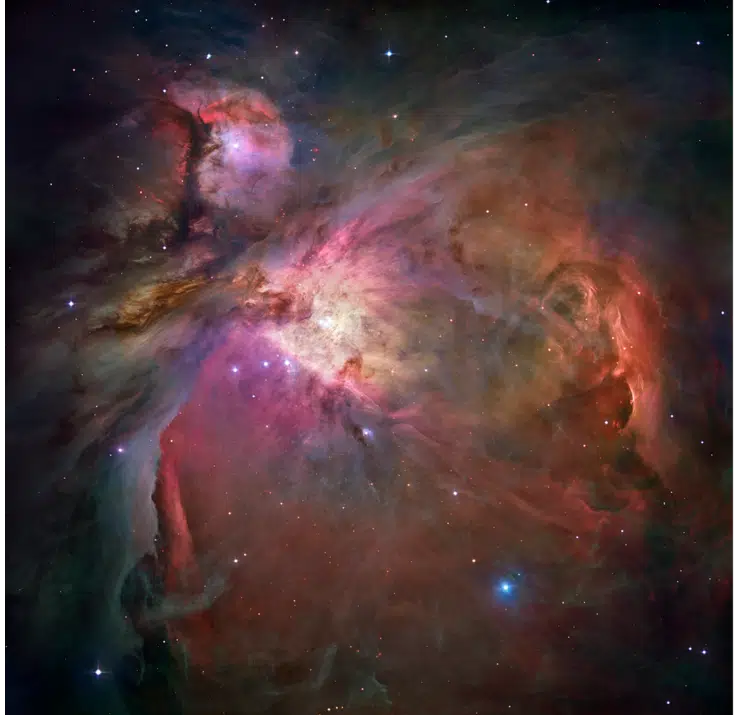
The Orion Nebula (M42) Credit: hubblesite.org
It appears to surround the middle star of the three in line that marks the hunter’s sword in the Orion constellation.
According to NASA, the majestic nebula can even be seen with the naked eye as it has an apparent magnitude of +4. The faintest object the human eye can see under the best conditions is +6 on the astronomical magnitude scale.
To find the Orion Nebula, you first need to locate the Orion constellation, then find Orion’s Belt. Under Orion’s Belt are three dimmer stars that form Orion’s sword, then in the middle of the sword is the Orion Nebula.
To the naked eye, the nebula appears as a fuzzy gray smudge under Orion’s Belt. But with the help of a pair of binoculars or a telescope, you should be able to pick out more of Orion’s distinguishing features, including the bright central part of the nebula called the “Huygenian region.”
You may also use this star map to see what other objects are within the Orion constellation.
According to NASA, in the central region of the Orion Nebula, four bright stars are in an open star cluster known as the Trapezium due to their trapezoidal arrangement.
In 2006, the Hubble Space Telescope captured the sharpest view of the Orion Nebula, a stunning image revealing more than 3000 stars.
RELATED: What Are the Dimmest Stars You Can See With a Telescope
2. Andromeda Galaxy (M31)
The Andromeda galaxy, our Milky Way’s closest neighbor, is the most distant object in the sky that you can see with your unaided eye — but only on a clear night from a location with a very dark sky.
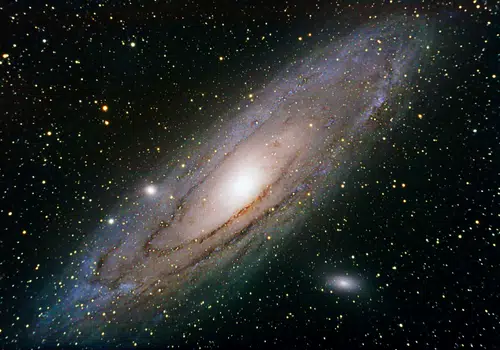
The Andromeda Galaxy (M31)
The visible fuzzy patch of stars in the galaxy stretches about as long as the width of the full moon and half as wide; only with significant magnification can you tell it stretches six times that length in fullness.
From mid-northern latitudes, you can see Andromeda – M31 – for at least part of every night, all year. But most people see the galaxy first around August or September when it’s high enough in the sky to be seen from evening until daybreak.
In late September and early October, the Andromeda galaxy shines in your eastern sky at nightfall.
You can find the galaxy in one of two ways. The easiest way is to use the constellation Cassiopeia the Queen. You can also use the Great Square of Pegasus.
To look for the constellation Cassiopeia, look northward on the sky’s dome for a pattern of stars shaped like the letter M or W.
If you can recognize the North Star, Polaris – and if you know how to find the Big Dipper – be aware that the Big Dipper and Cassiopeia move around Polaris like the hands of a clock, always opposite each other.
Once you’ve found Cassiopeia, look for its star Schedar. In the illustration above, see how Schedar points to the Andromeda galaxy.
Or you can refer to this star map to locate Andromeda between the constellations.
3. Whirlpool Galaxy (M51)
The Whirlpool Galaxy Galaxy (M51) is an interacting grand-design spiral galaxy in the constellation Canes Venatici.
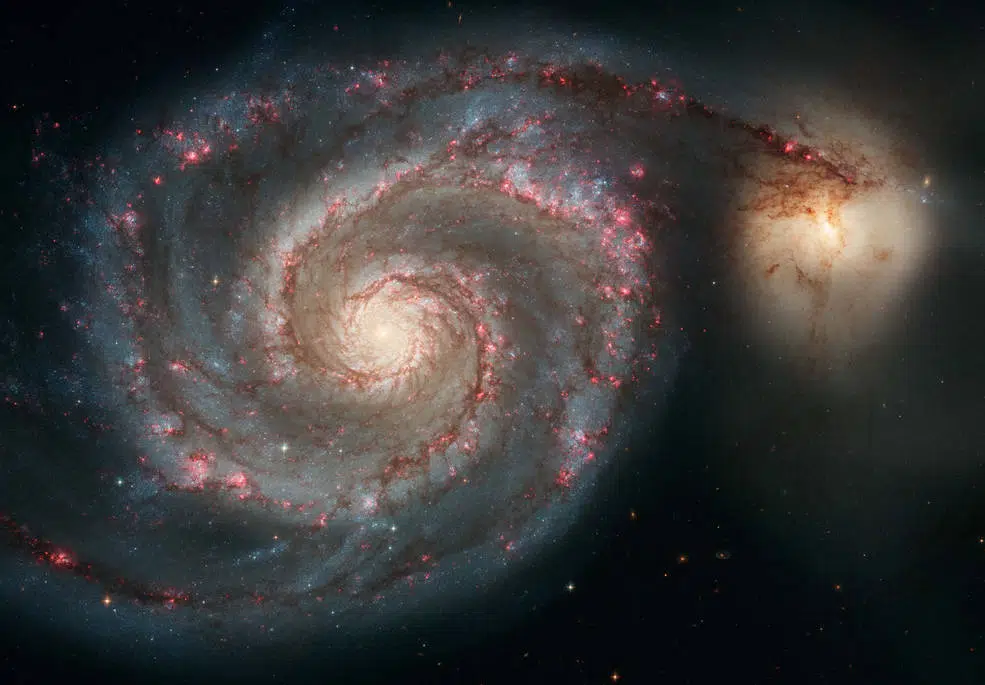
Whirlpool Galaxy (M51) Credit: NASA
The Whirlpool Galaxy can be spotted in a pair of binoculars by moving from the bright star Alkaid in Ursa Major towards Cor Caroli in Canes Venatici.
Messier 51 is a northern hemisphere deep-sky object that is bright enough to observe in amateur telescopes.
M51 is a galaxy we can see face-on, which reveals finer details. The companion galaxy is NGC 5195, also called M51b, and is in a merging process with the bigger M51a.
Thanks to this merging, the Whirlpool galaxy has a supermassive black hole at its heart.
It was observed and cataloged by famous astronomer Charles Messier in 1773 as Messier 51 (M51). It eventually earned the nickname “The Whirlpool” because it resembles a vortex in the water.
The Whirlpool’s most striking feature is its two curving arms, a hallmark of so-called grand-design spiral galaxies.
These arms serve an important purpose in spiral galaxies. The spiral arms are packed with stars, gas, and dust and make the perfect conditions for new stars to be born as that gas and dust coalesce, compress and collapse to begin forming a star.
To find out the exact location of the Whirlpool Galaxy, you can refer to this star chart.
4. The Dumbbell Nebula (M27)
M27, or the Dumbbell nebula, is one of the brightest planetary nebulae in the sky and can be seen toward the constellation of the Fox (Vulpecula) with binoculars.
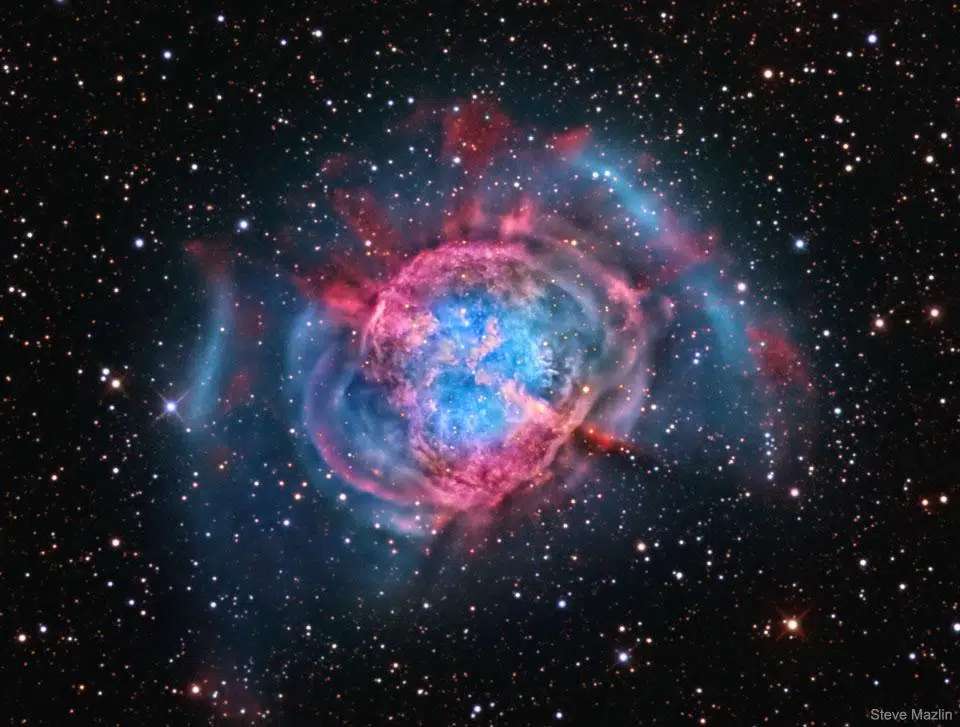
The Dumbbell Nebula (M27) Credit: NASA
If you can see the constellation Vulpecula from your backyard, there is a good chance you can view the Dumbbell Nebula with a small telescope.
With an apparent magnitude of +7.5, this nebula is brighter than most other nebulae in the night sky.
Messier 27 is the second brightest planetary nebula in the sky, second only to the Helix Nebula in Aquarius, and probably the easiest one to observe because it has a higher surface brightness than the Helix and is therefore easier to find.
As far as deep-sky objects go, the Dumbbell Nebula is quite small and bright. For reference, the Dumbbell Nebula is about one-quarter of the size of the full moon.
The Dumbbell Nebula is a popular target for beginners in astrophotography because it delivers incredible results with minimal exposure time.
Telescopes of nearly any focal length (250-1000mm+) can capture a pleasing image of this nebula, but using shorter focal lengths will record it quite small.
Check out our astrophotography telescope guide if you’re interested in taking pictures of deep space objects (DSOs).
Here is a star chart that can help you easily locate the Dumbbell Nebula.
5. Helix Nebula (NGC 7293)
The Helix Nebula (NGC 7293) is a bright, large planetary nebula located 650 light years from Earth in the constellation Aquarius.
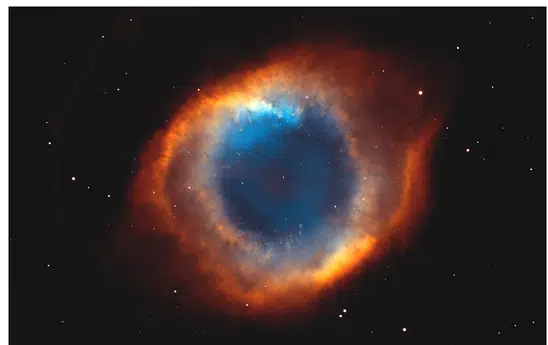
The Helix Nebula Credit:hubblesite.org
It is one of the closest planetary nebulae to Earth, as well as one of the brightest. With an apparent magnitude of 7.6 and an apparent size of 25 arcminutes.
Through binoculars or a small telescope, the Helix Nebula can be observed under the right conditions. For the best view, be sure to be well away from city light pollution and during the New Moon phase.
This planetary nebula will appear as a hazy, greenish cloud, similar to the visual appearance of the Dumbbell Nebula.
Its striking appearance has earned it the nickname the Eye of God Nebula.
When viewed through a pair of 10×50 binoculars, the Helix appears as a faint featureless oval-shaped disk.
A 100mm (4-inch) telescope reveals finer structural details. Through a 200mm (8-inch) reflector, it appears slightly oval with two thick arcs, gaps, and brightness variations across the structure.
The Helix is an example of a planetary nebula, the expanding shell of glowing gas around a dying, Sun-like star.
Despite the name, planetary nebulae have nothing to do with the planet’s formation.
These glowing gas clouds got their name because they look like the disks of planets when viewed through a small telescope.
This nebula was created when a star (similar to our own Sun) nears the end of its life.
You can refer to this star chart to locate and observe the Helix Nebula.
6. The Leo Triplet
The Leo Triplet, or the M66 Group, is a group of interacting spiral galaxies in the northern constellation Leo. The group consists of the galaxies Messier 65, Messier 66, and NGC 3628, also known as the Hamburger Galaxy.
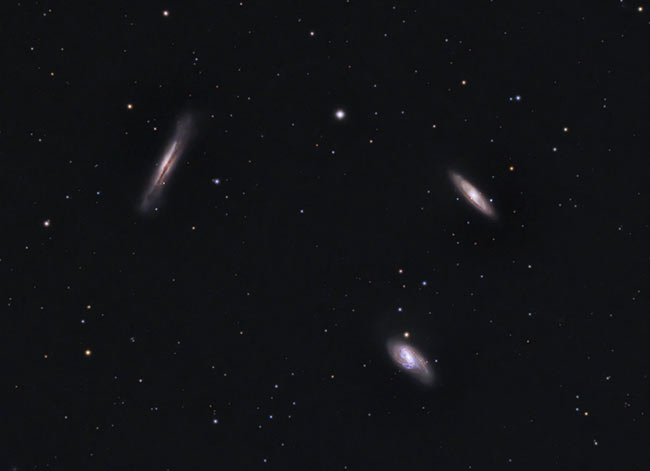
The Leo Triplet Credit: skynightmagazine.com
The three large spiral galaxies can be seen in a single field of view and are well-viewed even in small telescopes.
The constellation Leo is present most of the nights during the months of March through May, which is where you’ll find the Leo Triplet.
Each galaxy looks like it belongs in a different galactic category from its neighbor, but this is because they are all tilted at different angles from our perspective on Earth.
The M66 Group is located in the eastern part of the Leo constellation, along the line from the bright star Denebola to Regulus. The galaxies are located between the stars Chertan, Theta Leonis, and Iota Leonis.
M66 (the lower of the two remaining) and M65 are angled more favorably in terms of displaying their spiral structure, and their distinct arms can clearly be seen in most images of the target.
You may refer to this star chart to easily locate and observe the Leo Triplet.
7. Beta Cygni: Albireo
One of the great small-telescope showpieces of the sky, Albireo, the third-magnitude (3.0) Beta star of Cygnus, the Swan, is a magnificent visual double whose components have contrasting golden and blue colors.
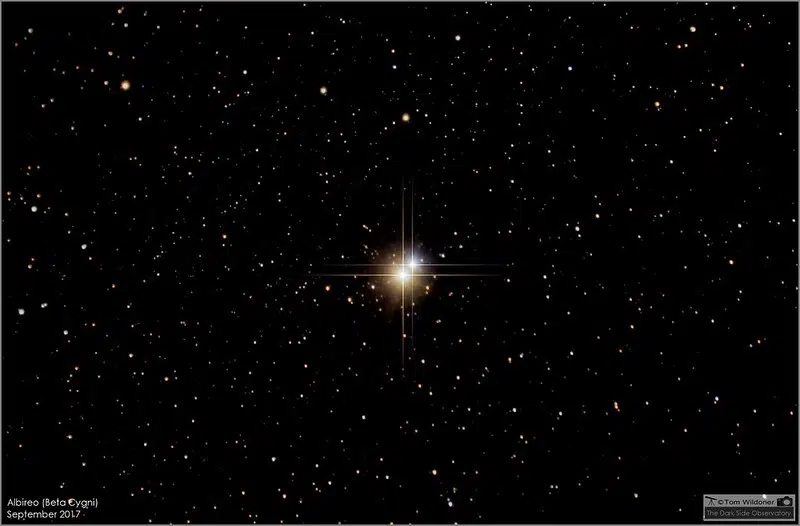
Beta Cygni – Albireo Credit: Tom Wildoner/Flickr
It appears as an optical double star in small telescopes. It is one of the best-known contrasting double stars in the sky and a popular target for amateur astronomers.
At first glance, it doesn’t particularly stand out. But viewing this star through a small telescope can take your breath away. It resolves into a striking double, with one component a lovely gold star and the other a dimmer blue close by.
The Albireo is easy to find if you can locate Cygnus the Swan. Cygnus has an easy-to-recognize shape, that of a cross, and the constellation is also known as the Northern Cross.
The brightest star in Cygnus, called Deneb, marks the head of the Cross or the Tail of the Swan. Albireo marks the base of the Cross or the Head of Cygnus.
Check out this star chart to locate the Albireo double star.
8. Carina Nebula (NGC 3372)
The Carina Nebula is a giant nebula 9000 light years from us in the Sagittarius Arm of the Galaxy.
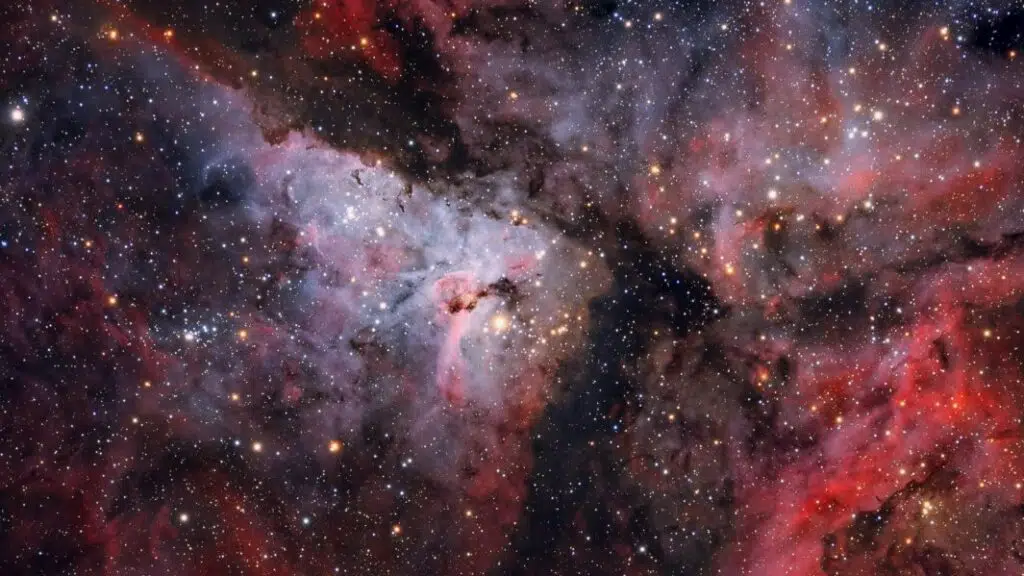
Carina Nebula (NGC 3372) Credit: NASA
Although it is a large distance from us, the central region of this nebula is bright enough to see with the naked eye (although only from equatorial and southern latitudes on Earth).
The vivid colors seen in pictures of nebulae usually only appear in photographs, the human eye is not very sensitive to dim colors, and so with the naked eye, a nebula such as the Carina Nebula only appears to be white.
The Carina Nebula also contains several other stars that are among the hottest and most massive known, each about 10 times as hot and 100 times as massive as our Sun.
The Carina Nebula, with an overall diameter of more than 200 light-years, is one of the outstanding features of the southern-hemisphere part of the Milky Way.
You may refer to this star chart to find and observe the Carina nebula.
9. Jewel Box Cluster (C94)
The Jewel Box (also known as the Kappa Crucis Cluster, NGC 4755, or Caldwell 94) is an open cluster in the constellation Crux, originally discovered by Nicolas Louis de Lacaille in 1751–1752.
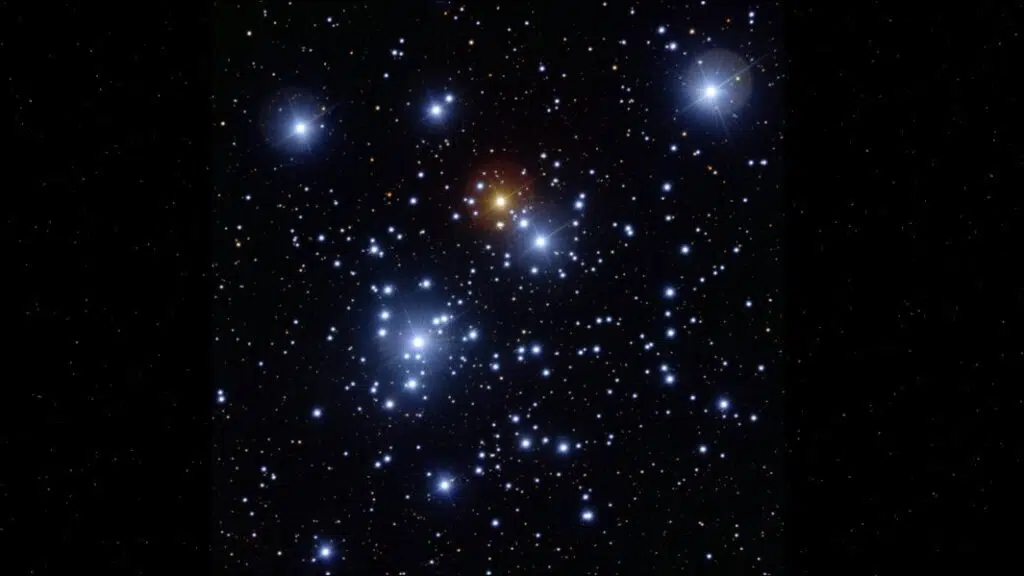
Jewel Box Cluster (C94) Credit: NASA
It is easily visible to the naked eye as a hazy star some 1.0° southeast of the first-magnitude star Mimosa (Beta Crucis).
This hazy star was given the Bayer star designation “Kappa Crucis,” from which the cluster takes one of its common names.
The Jewel Box cluster is a spartan collection of just over 100 stars.
Although the Jewel Box cluster is visible to the naked eye, without magnification, it will masquerade as a single star.
Binoculars will refine the cluster into separate members, while a telescope will provide an even more spectacular view of Caldwell 94’s colorful stellar jewels.
Here’s a star chart to assist you in discovering the magnificent Jewel Box Cluster.
10. Omega Centauri (NGC 5139)
The Omega Centauri globular cluster is a beautiful, ancient collection of gravitationally bound stars located in the direction of the Centaurus constellation.
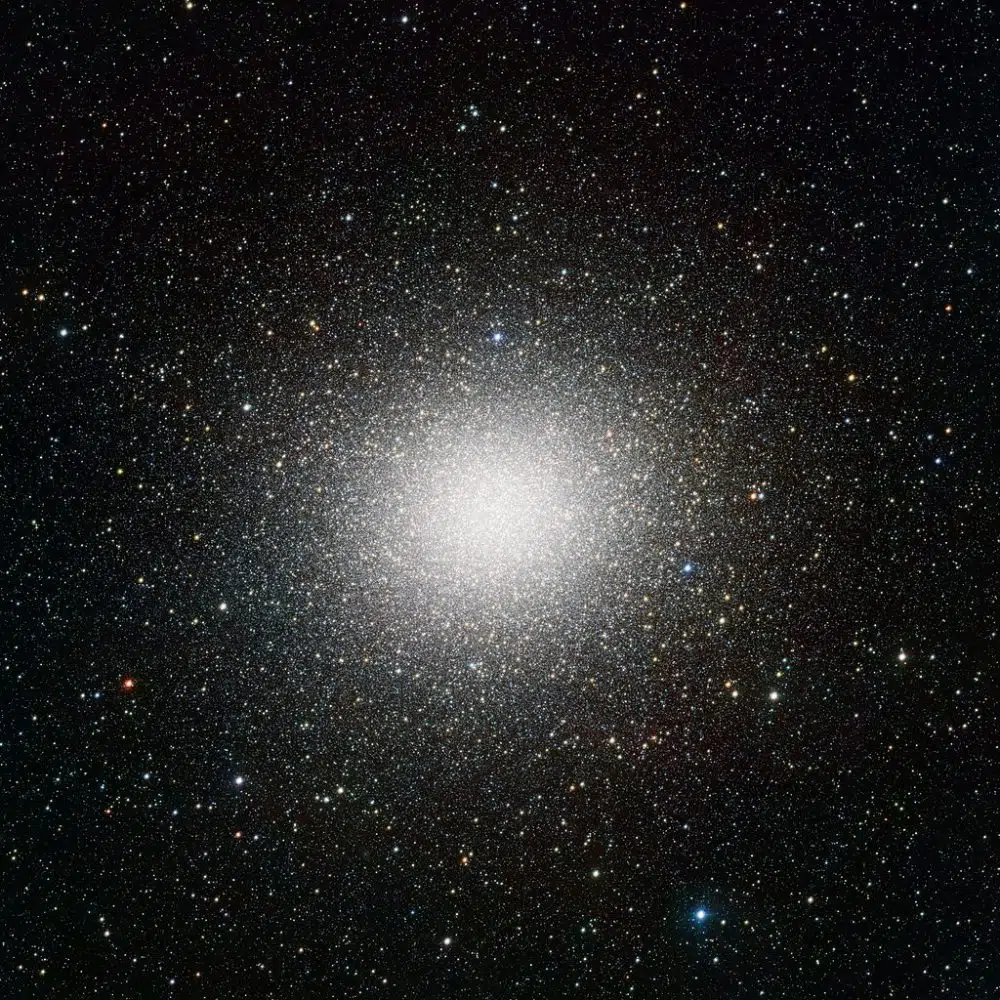
Omega Centauri (NGC 5139) Credit: constellation-guide.com
Also known as NGC 5139, it is a fine example of a globular cluster, which is some of the oldest objects in the Universe.
The Omega Centauri globular cluster contains up to 10 million stars, and it is the brightest, largest, and most massive globular star cluster in our galaxy, the Milky Way.
Under good, dark conditions away from light pollution, the Omega Centauri globular cluster can be seen with the naked eye, but binoculars and even a small telescope will start to reveal its true, glittering beauty.
Omega Centauri is about 50% larger than the most prominent globular cluster in the Northern Hemisphere, M13 in Hercules.
A 150mm (6-inch) scope under dark skies resolves the cluster into a number of stellar points. The best view of the Omega comes with 250mm (10-inch) or larger scopes.
Here is a star chart that you can refer to in order to locate Omega Centauri.
Conclusion
There are certainly a great number of objects that can be observed in the sky at night that I could have included on the list.
I highly recommend the book Turn Left at Orion by Guy Consolmagno and Dan M. Davis. It is a book filled with maps and sketches of all of the Deep Sky Objects that are interesting to look at in the sky.
These maps and sketches include sketches of what can be seen in large and small telescopes. If you have a powerful telescope, you will never be at a loss for things to look at in the night sky. It seems like there is no end to the sky.
There are countless double stars and deep sky objects that can be found with a telescope that has an aperture of 6 or 8 inches, and there are still hundreds more that can be found with a telescope that has a smaller aperture.
For instance, a telescope with a focal length of 4 inches can gather sufficient light to observe all of the Messier objects.
Written by:

Kavya Joshi
My love affair with space began in a field in India at the age of 7, when I looked up at the Milky Way for the first time. Ever since, I have been attempting to cram in every fact about the Universe, I can find into my head.
ABOUT US
We are a team of active amateur astronomers, here to help you with all your astronomy and science related needs – this is anything, from reviewing the latest telescopes to be released to talking about gravity and neurons. The Big Bang Optics was started because of our love for astronomy and to help others like us find the best telescope and accessories.
LEGAL DISCLAIMER
The Big Bang Optics is a participant in the Amazon Services LLC Associates Program, an affiliate advertising program designed to provide a means for sites to earn advertising fees by advertising and linking to Amazon.com. The Big Bang Optics also participates in affiliate programs with Clickbank and other sites. The Big Bang Optics is compensated for referring traffic and business to these companies.

